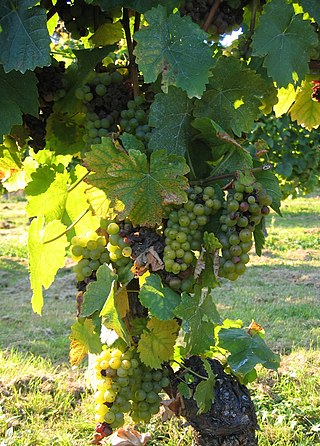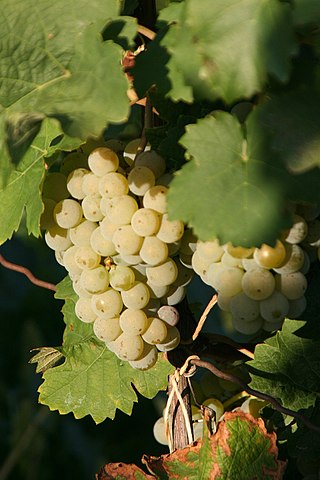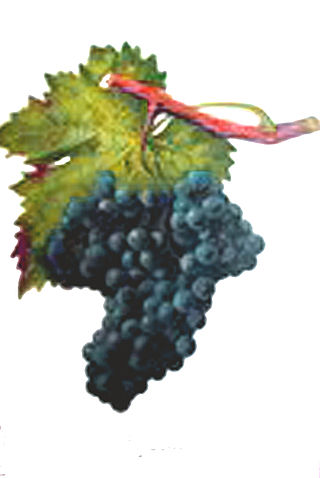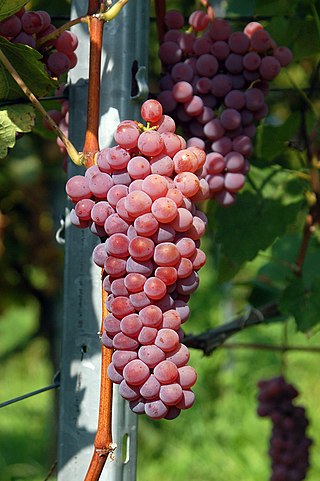
Rondo is a dark-skinned grape variety, used for making red wine. It is a hybrid grape or inter-specific crossing. It was created in 1964 by Professor Vilém Kraus in then-Czechoslovakia by crossing the varieties Zarya Severa and St. Laurent. He offered it to Dr. Helmut Becker (1927-1990) of the Geisenheim Grape Breeding Institute who conducted further work on it, which explains why the grape is known under a Geisenheim designation. The variety was first planted for research and later in bigger scale in the mid 1980s by Thomas Walk Vineyard in Ireland under the name Amurensis Walk; it was named Rondo in 1997.

The Geisenheim Grape Breeding Institute was founded in 1872 and is located in the town of Geisenheim, in Germany's Rheingau region. In 1876 Swiss-born professor Hermann Müller joined the institute, where he developed his namesake grape variety Müller-Thurgau, which became Germany's most-planted grape variety in the 1970s. Professor Helmut Becker worked at the institute from 1964 until his death in 1989.
Breidecker is white variety of grape. It is a hybrid grape, an interspecific crossing × Seibel 7053. It can be used to make a German style light white wine with apple and pear flavors. "This cultivar was released by the Geisenheim Research Station, Germany, in 1962. Has the technical name GM 4894. It was derived from a Müller-Thurgau cross with the Chancellor hybrid cultivar and can currently be found in limited areas in the South Island of New Zealand, where it is mainly used for producing somewhat neutral varietal and blend white wines. Resistant to bunch rot and downy mildew fungus diseases. Breidecker was named after Heinrich Breidecker, one of New Zealand pioneer grape growers."

Ehrenfelser is a white wine grape variety of German origin. It was created by Dr. Heinrich Birk (1898-1973) at the Geisenheim Grape Breeding Institute in 1929, by crossing Riesling with what was thought at the time to be Silvaner, but DNA markers have since indicated it was the Alsace variety Knipperlé.

Morio Muscat is a white wine grape that was created by viticulturalist Peter Morio at the Geilweilerhof Institute for Grape Breeding in the Palatinate in 1928. He claimed to have crossed the varieties Silvaner and Pinot blanc, but based on the variety's properties it has been speculated that he actually crossed Silvaner and Muscat Blanc à Petits Grains. But so far this speculation has yet to be conclusively proven. The grape is highly aromatic with a "grapey" characteristic reminiscent of Muscat grape varieties. The grape is rarely used for varietal wines because it requires a high level of ripeness to avoid producing wine with a "mousey" flavor, a coarse texture and overabundance of acidity.

The Kerner grape is an aromatic white grape variety. It was bred in 1929 by August Herold by crossing Trollinger and Riesling. Herold was working at a plant breeding station in Lauffen in the Württemberg region of Germany. This station belonged to a state breeding institute headquartered in Weinsberg. It received varietal protection and was released for general cultivation in 1969.

Argant is an ancient variety of red wine grape. It originated in Spain and may have been taken to eastern France by the Romans. It was briefly popular, but little of it remains today. It used to be common in southwestern Germany and in Austria under the name Gänsfüßer. The name refers to the leaf shape, which resembles the foot of a goose.

Orléans is a variety of white grape which up until the 19th century was much grown in Germany, but in very little use since the early 20th century. It has large berries with thick skins and a high yield. Young Orléans wine has been described as somewhat reminiscent of wine made from white varieties of the pinot family, but with pineapple aromas.

Solaris is a variety of grape used for white wine. It was created in 1975 at the grape breeding institute in Freiburg, Germany by agricultural scientist Norbert Becker.

Ortega is a grape variety used for white wine. It was created in 1948 by Hans Breider at the Bayerischen Landesanstalt für Wein-, Obst- und Gartenbau in Würzburg and was released with varietal protection in 1981. It is a cross between Müller-Thurgau and Siegerrebe. Breider chose to name the variety in honour of the Spanish poet and philosopher José Ortega y Gasset.

Dunkelfelder is a dark-skinned variety of grape used for red wine. It was created by German viticulturalist Gustav Adolf Froelich (1847-1912). He probably crossed Färbertraube with Blauer Portugieser. The variety, initially called Froelich V 4-4, did not receive any attention for several decades until work was continued on it at Geisenheim grape breeding institute in the 1930s. It was named Dunkelfelder by ampelographer Helmut Becker, due to its unclear parentage and its dark colour. Dunkelfelder received varietal protection and was released for general cultivation in 1980.
Orion is a white wine grape variety of German origin. It was created by Dr. Gerhardt Alleweldt (1927-2005) at the Geilweilerhof Institute for Grape Breeding in Siebeldingen in 1964, by crossing the Vitis vinifera variety Optima with the hybrid grape Villard Blanc. Therefore, Orion is itself a hybrid grape rather than a pure Vitis vinifera.
Roesler is a red Austrian wine grape developed in 1970 by Dr. Gertraud Mayer at Höhere Bundeslehranstalt und das Bundesamt für Wein- und Obstbau in Klosterneuburg, Austria. It is the result of a crossing Zweigelt x. It is named after the former director of Austria's oldest viticultural college, Leonard Roesler (1839–1910), who was a German-Austrian chemist and oenologist. The variety is deep in colour and with abundant extract. It is frost resistant and can withstand temperatures as low as -25°C (-13°F). It is also resistant to mildew.

Bronner is a white grape variety used for wine. It was bred in 1975 by Norbert Becker at the viticultural institute in Freiburg, Germany. The variety was initially known under its breeding code FR 250-75, and was later named in honour of Johann Philipp Bronner (1792-1864), who was a German pharmacist and viticultural pioneer. It received varietal protection in 1977.

Olmo grapes are wine and table grape varieties produced by University of California, Davis viticulturist Dr. Harold Olmo. Over the course of his nearly 50-year career, Dr. Olmo bred a wide variety of both grapes by means of both crossing varieties from the same species or creating hybrid grapes from cultivars of different Vitis species.
Ravat blanc is a white hybrid grape variety that is a crossing of Chardonnay and a Seibel grape. While the Vitis International Variety Catalogue (VIVC) maintained by the Geilweilerhof Institute for Grape Breeding lists Seibel 5474 as the second parent, Master of Wine Jancis Robinson notes that other authors list Seibel 8724 as the parent. The grape is often confused with the white hybrid grape Vignoles that is often called just Ravat.
Cabernet blanc is a white German and Swiss wine grape variety that is a crossing of the French wine grape Cabernet Sauvignon and the hybrid grape Regent. The grape was bred by Swiss grape breeder Valentin Blattner in 1991. Cabernet blanc has strong resistance to most grape disease including botrytis bunch rot, downy and powdery mildew and tends to produce loose clusters of small, thick-skinned grape berries which can hang on the vine late into the harvest season to produce dessert wines. Today the grape is found primarily in the Palatinate wine region of Germany with some experimental plantings in Spain and the Netherlands. In France, in the Languedoc, Domaine La Colombette is heavily investing in PIWI grapes. Amongst others the Cabernet Blanc in their cuvée "Au Creux du Nid", is gaining wide acclaim.

Muscat bleu is a red Swiss wine and table grape variety that is a hybrid of Garnier 15-6 and Perle noire. The grape was developed in Peissy in the Canton of Geneva by Swiss grape breeder Charles Garnier in the 1930s. Today the grape is used as both a table grape and for winemaking, producing wines that Master of Wine Jancis Robinson describe as "soft and grapey". Outside Switzerland, some plantings of Muscat bleu can also be found in Belgium.

Souvignier gris is a white German wine grape variety that was created in 1983 by Dr. Norbert Becker. It is a cross between Seyval blanc and Zähringer, but was originally thought to be a cross between Cabernet Sauvignon and Bronner.
Zarya severa is a red grape variety. It is a descendant of the Asiatic wild grape Vitis amurensis and the grape Malingre Précoce of French origin and is thus a hybrid vine. The crossing took place at the Potapenko Viticulture Research Institute in Rostov Oblast, Russia in 1936. Because of its high winter frost resistance as well as its resistance to downy mildew, this variety, often mentioned by breeders in Eastern Europe, became a major breeding stock in the search for new varieties.














